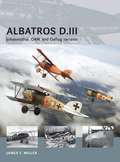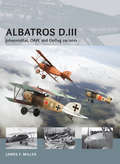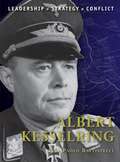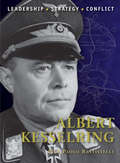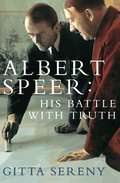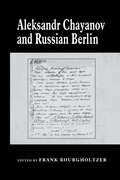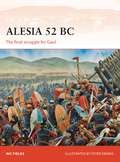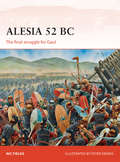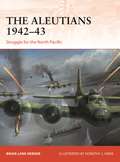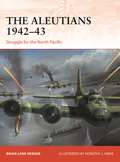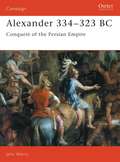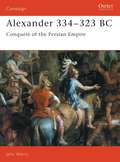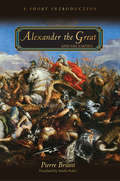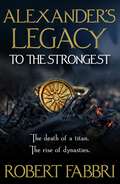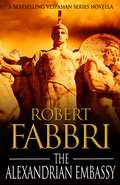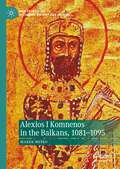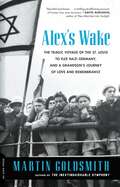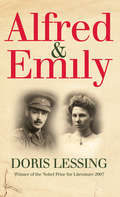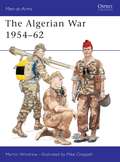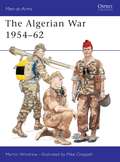- Table View
- List View
Albatros D.III: Johannisthal, OAW, and Oeffag variants (Air Vanguard #13)
by Henry Morshead Adam Tooby James F. MillerIn 1916 German aerial domination, once held sway by rotary-engined Fokker and Pfalz E-type wing-warping monoplanes, had been lost to the more nimble French Nieuports and British DH 2s which not only out-flew the German fighters but were present in greater numbers. Born-from-experience calls from German fighter pilots requested that, rather than compete with the maneuverability of these adversaries, new single-engine machines should be equipped with higher horsepower engines and armed with two rather than the then-standard single machine gun. The Robert Thelen-led Albatros design bureau set to work on what became the Albatros D.I and D.II and by April 1916, they had developed a sleek yet rugged machine that featured the usual Albatros semi-monocoque wooden construction and employed a 160hp Mercedes D.III engine with power enough to equip the aeroplane with two forward-firing machine guns. In all, 500 D.IIIs and 840 D.III(OAW)s were produced and saw heavy service throughout 1917.
Albatros D.III: Johannisthal, OAW, and Oeffag variants (Air Vanguard #13)
by Adam Tooby Mr Henry Morshead James F. MillerIn 1916 German aerial domination, once held sway by rotary-engined Fokker and Pfalz E-type wing-warping monoplanes, had been lost to the more nimble French Nieuports and British DH 2s which not only out-flew the German fighters but were present in greater numbers. Born-from-experience calls from German fighter pilots requested that, rather than compete with the maneuverability of these adversaries, new single-engine machines should be equipped with higher horsepower engines and armed with two rather than the then-standard single machine gun. The Robert Thelen-led Albatros design bureau set to work on what became the Albatros D.I and D.II and by April 1916, they had developed a sleek yet rugged machine that featured the usual Albatros semi-monocoque wooden construction and employed a 160hp Mercedes D.III engine with power enough to equip the aeroplane with two forward-firing machine guns. In all, 500 D.IIIs and 840 D.III(OAW)s were produced and saw heavy service throughout 1917.
Albert Kesselring (Command)
by Adam Hook Pier Paolo BattistelliAlthough he is mostly remembered for his part in the campaign in Italy from 1943 to 1945, Generalfeldmarschall Albert Kesselring was also chief of staff of the Luftwaffe in 1936–37, playing a crucial role in the shaping of the service for the coming war. As commander of Luftflotte 1 in Poland and Luftflotte 2 in France and the Low Countries, he was responsible for supporting the armoured spearheads of the German Army as they undertook their Blitzkrieg campaigns. With the Fall of France, the Battle of Britain began and Luftlotte 2 was the main force in the air attack against the British air defences, with Kesselring planning many raids. Following the war Kesselring was tried and convicted of war crimes following a number of massacres of civilians in Italy. He was sentenced to death, later commuted to life imprisonment before being released on the grounds of ill health in October 1952. Here Pier Paolo Battistelli provides a detailed study of one of the most famous German commanders of World War II.
Albert Kesselring (Command #27)
by Adam Hook Pier Paolo BattistelliAlthough he is mostly remembered for his part in the campaign in Italy from 1943 to 1945, Generalfeldmarschall Albert Kesselring was also chief of staff of the Luftwaffe in 1936–37, playing a crucial role in the shaping of the service for the coming war. As commander of Luftflotte 1 in Poland and Luftflotte 2 in France and the Low Countries, he was responsible for supporting the armoured spearheads of the German Army as they undertook their Blitzkrieg campaigns. With the Fall of France, the Battle of Britain began and Luftlotte 2 was the main force in the air attack against the British air defences, with Kesselring planning many raids. Following the war Kesselring was tried and convicted of war crimes following a number of massacres of civilians in Italy. He was sentenced to death, later commuted to life imprisonment before being released on the grounds of ill health in October 1952. Here Pier Paolo Battistelli provides a detailed study of one of the most famous German commanders of World War II.
Albert Speer: His Battle With Truth
by Gitta SerenyFrom 1942 Speer was the second most powerful man in the Reich and Hitler’s right-hand man. Gitta Sereny, through twelve years of research and through many conversations with Speer, his friends and colleagues, reveals how Speer came to terms with his own acts and failures to act, his progress from moral extinction to moral self-education and the question of his real culpability in the Nazi crimes.
The Alchemist’s Secret (Ben Hope #1)
by Scott MarianiTHE #1 BESTSELLER Introducing the explosive first Ben Hope adventure 'Non-stop action – this book delivers’ STEVE BERRY
Aleksandr Chayanov and Russian Berlin
by Frank BourgholtzerAleksandr Chayanov lived and worked in England and Germany in the 1920s, when he wrote many letters. He was also forced to write autobiographical material after his arrest in 1930. Frank Bourgholtzer uses this material in his account of this Russian utopian.
Aleksandr Chayanov and Russian Berlin
by Frank BourgholtzerAleksandr Chayanov lived and worked in England and Germany in the 1920s, when he wrote many letters. He was also forced to write autobiographical material after his arrest in 1930. Frank Bourgholtzer uses this material in his account of this Russian utopian.
Alesia 52 BC: The final struggle for Gaul (Campaign)
by Peter Dennis Nic FieldsIn 52 BC Caesar's continued strategy of annihilation had engendered a spirit of desperation, which detonated into a revolt of Gallic tribes under the leadership of the charismatic young Arvernian noble Vercingetorix. Major engagements were fought at Noviodunum, Avaricum, and Gergovia, with the last action being the most serious reverse that Caesar faced in the whole of the Gallic War. However, Vercingetorix soon realized that he was unable to match the Romans in pitched battle. Taking advantage of the tribesmen's superior knowledge of their home territory, Vercingetorix began a canny policy of small war and defensive manoeuvres, which gravely hampered Caesar's movements by cutting off his supplies. For Caesar it was to be a grim summertime – his whole Gallic enterprise faced disaster. In the event, by brilliant leadership, force of arms, and occasionally sheer luck, Caesar succeeded in stamping out the revolt in a long and brutal action culminating in the siege of Alesia. Vercingetorix finally surrendered and Alesia was to be the last significant resistance to the Roman will. Never again would a Gallic warlord independent of Rome hold sway over the Celts of Gaul.
Alesia 52 BC: The final struggle for Gaul (Campaign)
by Peter Dennis Nic FieldsIn 52 BC Caesar's continued strategy of annihilation had engendered a spirit of desperation, which detonated into a revolt of Gallic tribes under the leadership of the charismatic young Arvernian noble Vercingetorix. Major engagements were fought at Noviodunum, Avaricum, and Gergovia, with the last action being the most serious reverse that Caesar faced in the whole of the Gallic War. However, Vercingetorix soon realized that he was unable to match the Romans in pitched battle. Taking advantage of the tribesmen's superior knowledge of their home territory, Vercingetorix began a canny policy of small war and defensive manoeuvres, which gravely hampered Caesar's movements by cutting off his supplies. For Caesar it was to be a grim summertime – his whole Gallic enterprise faced disaster. In the event, by brilliant leadership, force of arms, and occasionally sheer luck, Caesar succeeded in stamping out the revolt in a long and brutal action culminating in the siege of Alesia. Vercingetorix finally surrendered and Alesia was to be the last significant resistance to the Roman will. Never again would a Gallic warlord independent of Rome hold sway over the Celts of Gaul.
The Aleutians 1942–43: Struggle for the North Pacific (Campaign)
by Brian Lane HerderIt is often forgotten that during World War II, the Japanese managed to successfully invade and conquer a precious part of American home soil – the first time this had happened since 1815. Capturing the Aleutian Islands, located in Alaska territory, was seen by the Japanese as vital in order to shore up their northern defensive perimeter. Fighting in the Aleutians was uniquely brutal. It is a barren, rugged archipelago of icy mountains and thick bogs, with a climate of constant snow, freezing rains and windstorms. These geographic conditions tended to neutralize traditional American strengths such as air power, radar, naval bombardment and logistics. The campaign to recapture the islands required extensive combined-ops planning, and inflicted on the United States its second highest casualty rate in the Pacific theatre. Featuring the largest Japanese banzai charge of the war, first use of pre-battle battleship bombardment in the Pacific and the battle at the Komandorski Islands, this is the full story of the forgotten battle to liberate American soil from the Japanese.
The Aleutians 1942–43: Struggle for the North Pacific (Campaign)
by Brian Lane HerderIt is often forgotten that during World War II, the Japanese managed to successfully invade and conquer a precious part of American home soil – the first time this had happened since 1815. Capturing the Aleutian Islands, located in Alaska territory, was seen by the Japanese as vital in order to shore up their northern defensive perimeter. Fighting in the Aleutians was uniquely brutal. It is a barren, rugged archipelago of icy mountains and thick bogs, with a climate of constant snow, freezing rains and windstorms. These geographic conditions tended to neutralize traditional American strengths such as air power, radar, naval bombardment and logistics. The campaign to recapture the islands required extensive combined-ops planning, and inflicted on the United States its second highest casualty rate in the Pacific theatre. Featuring the largest Japanese banzai charge of the war, first use of pre-battle battleship bombardment in the Pacific and the battle at the Komandorski Islands, this is the full story of the forgotten battle to liberate American soil from the Japanese.
Alexander 334–323 BC: Conquest of the Persian Empire (Campaign)
by John WarryAlexander of Macedonia was undoubtedly one of the greatest generals of all time. This book, by John Warry, an expert on the warfare of the Classical world, examines the principle battles of Alexander's campaigns in detail. The battles of the Granicus, Issus, Gaugamela, Hydaspes and the difficult siege of Tyre are all discussed at length. These careful studies shed light on Macedonian tactics: in particular the combination of armoured infantry phalanx with fast-moving cavalry. The men and equipment of both Alexander and his Persian enemies are also examined, providing a comprehensive insight into Alexander's life and military actions. Men-at-Arms 148 and Campaign 7 are also available in a single volume special edition as 'Alexander the Great'.
Alexander 334–323 BC: Conquest of the Persian Empire (Campaign #7)
by John WarryAlexander of Macedonia was undoubtedly one of the greatest generals of all time. This book, by John Warry, an expert on the warfare of the Classical world, examines the principle battles of Alexander's campaigns in detail. The battles of the Granicus, Issus, Gaugamela, Hydaspes and the difficult siege of Tyre are all discussed at length. These careful studies shed light on Macedonian tactics: in particular the combination of armoured infantry phalanx with fast-moving cavalry. The men and equipment of both Alexander and his Persian enemies are also examined, providing a comprehensive insight into Alexander's life and military actions. Men-at-Arms 148 and Campaign 7 are also available in a single volume special edition as 'Alexander the Great'.
Alexander Hamilton (Great Lives)
by Ron ChernowYou've seen the show, you've sung the songs, now read the full story of America's most misunderstood founding father. 'I was swept up by the story. I thought it 'out-Dickens' Dickens in the unlikeliness of this man's rise from his humble beginnings in Nevis in the Caribbean, to changing, helping shape our young nation. And it's uniquely an immigrant story and it's uniquely a story about writers... It's an amazing biography' LIN-MANUEL MIRANDAAlexander Hamilton was an illegitimate self-taught orphan from the Caribbean who overcame all the odds to become George Washington's aide-de-camp and the first Treasury Secretary of the United States.Few figures in American history are more controversial than Alexander Hamilton. In this masterful work, Chernow shows how the political and economic power of America today is the result of Hamilton's willingness to champion ideas that were often wildly disputed during his time. He charts his titanic feuds with Jefferson, Adams, Madison, Monroe and Burr; his highly public affair with Maria Reynolds; his loving marriage to his loyal wife Eliza; and the notorious duel with Aaron Burr that led to his death in July 1804.
Alexander the Great and His Empire: A Short Introduction (PDF)
by Pierre Briant Amélie KuhrtThis is the first publication in English of Pierre Briant's classic short history of Alexander the Great's conquest of the Persian empire, from the Mediterranean to Central Asia. Eschewing a conventional biographical focus, this is the only book in any language that sets the rise of Alexander's short-lived empire within the broad context of ancient Near Eastern history under Achaemenid Persian rule, as well as against Alexander's Macedonian background. As a renowned historian of both the Macedonians and the Persians, Briant is uniquely able to assess Alexander's significance from the viewpoint of both the conquerors and the conquered, and to trace what changed and what stayed the same as Alexander and the Hellenistic world gained ascendancy over Darius's Persia. After a short account of Alexander's life before his landing in Asia Minor, the book gives a brief overview of the major stages of his conquest. This background sets the stage for a series of concise thematic chapters that explore the origins and objectives of the conquest; the nature and significance of the resistance it met; the administration, defense, and exploitation of the conquered lands; the varying nature of Alexander's relations with the Macedonians, Greeks, and Persians; and the problems of succession following Alexander's death. For this translation, Briant has written a new foreword and conclusion, updated the main text and the thematic annotated bibliography, and added a substantial appendix in which he assesses the current state of scholarship on Alexander and suggests some directions for future research. More than ever, this masterful work provides an original and important perspective on Alexander and his empire.
Alexander's Legacy: To The Strongest (Alexander's Legacy #1)
by Robert Fabbri'An excellent new series by the consistently brilliant Robert Fabbri' Sunday Sport_____________________________Let the battles begin...'I foresee great struggles at my funeral games.'Babylon, 323 BC: Alexander the Great is dead, leaving behind him the largest, and most fearsome, empire the world has ever seen. As his final breaths fade in a room of seven bodyguards, Alexander refuses to name a successor. But without a natural heir, who will take the reins?As the news of the king's sudden and unexpected death ripples across the land, leaving all in disbelief, the ruthless battle for the throne begins. What follows is a devious, tangled web of scheming and plotting, with alliances quickly made and easily broken, each rival with their own agenda.But who will emerge victorious: the half-chosen; the one-eyed; the wildcat; the general; the bastard; the regent? In the end, only one man, or indeed woman, will be left standing...
The Alexandrian Embassy (A Crossroads Brotherhood Novella #4)
by Robert FabbriRome, AD 39: Rome. Marcus Salvius Magnus, leader of the Crossroads Brotherhood, is buying a dangerous cargo of illegal weaponry. When a deal which will ensure Magnus's dominance over Rome's criminal underworld goes sour, Magnus must regain the shipment by any means necessary...As the rival West Viminal Brotherhood threatens his whole operation, Magnus fights to outwit his opponents whilst juggling the threat of the law and the demands of his patron. With enemies, plots and intrigue on all sides, can Magnus manage to evade death long enough to emerge victorious?A VESPASIAN NOVELLA______________________________________________Don't miss Robert Fabbri's epic new series Alexander's Legacy
Alexios I Komnenos in the Balkans, 1081–1095 (New Approaches to Byzantine History and Culture)
by Marek MeškoThis book provides a new military history of Byzantine emperor Alexios I Komnenos's campaigns in the Balkans, during the first fourteen years of his rule. While the tactics and manoeuvres Alexios used against Robert Guiscard's Normans are relatively well-known, his strategy in dealing with Pecheneg and Cuman adversaries in the region has received less attention in historical scholarship. This book provides a much-need synthesis of these three closely linked campaigns – often treated as discrete events – revealing a surprising coherence in Alexios' response, and explores the position of Byzantium's army and navy on the eve of the First Crusade.
Alex's Wake: The Tragic Voyage of the St. Louis to Flee Nazi Germany-and a Grandsons Journey of Love and Remembrance
by Martin GoldsmithAlex's Wake is a tale of two parallel journeys undertaken seven decades apart. In the spring of 1939, Alex and Helmut Goldschmidt were two of more than 900 Jewish refugees fleeing Nazi Germany aboard the St. Louis, "the saddest ship afloat” (New York Times). Turned away from Cuba, the United States, and Canada, the St. Louis returned to Europe, a stark symbol of the world's indifference to the gathering Holocaust. The Goldschmidts disembarked in France, where they spent the next three years in six different camps before being shipped to their deaths in Auschwitz.In the spring of 2011, Alex's grandson, Martin Goldsmith, followed in his relatives' footsteps on a six-week journey of remembrance and hope, an irrational quest to reverse their fate and bring himself peace. Alex's Wake movingly recounts the detailed histories of the two journeys, the witnesses Martin encounters for whom the events of the past are a vivid part of a living present, and an intimate, honest attempt to overcome a tormented family legacy.
Alex's Wake: The Tragic Voyage of the St. Louis to Flee Nazi Germany-and a Grandson’s Journey of Love and Remembrance
by Martin GoldsmithAlex's Wake is a tale of two parallel journeys undertaken seven decades apart. In the spring of 1939, Alex and Helmut Goldschmidt were two of more than 900 Jewish refugees fleeing Nazi Germany aboard the St. Louis, "the saddest ship afloat” (New York Times). Turned away from Cuba, the United States, and Canada, the St. Louis returned to Europe, a stark symbol of the world's indifference to the gathering Holocaust. The Goldschmidts disembarked in France, where they spent the next three years in six different camps before being shipped to their deaths in Auschwitz.In the spring of 2011, Alex's grandson, Martin Goldsmith, followed in his relatives' footsteps on a six-week journey of remembrance and hope, an irrational quest to reverse their fate and bring himself peace. Alex's Wake movingly recounts the detailed histories of the two journeys, the witnesses Martin encounters for whom the events of the past are a vivid part of a living present, and an intimate, honest attempt to overcome a tormented family legacy.
Alfred and Emily
by Doris LessingDoris Lessing’s first book after winning the Nobel Prize for Literature revisits her childhood in Southern Africa and the lives, both fictional and factual, that her parents led.
The Algerian War 1954–62 (Men-at-Arms)
by Mike Chappell Mr Martin WindrowIt is hard to convey the public impact of France's war to maintain her colonial grip on Algeria; yet in the late 1950s this ugly conflict dominated Europe's media to almost the same extent as would Vietnam ten years later. It brought France to the very verge of military coup d'etat; it destroyed thousands of careers; bitterly divided the French military and political classes for a generation; and sent hundreds of thousands of European settler families into often ruinous exile. This title details the history, organisation, equipment and uniforms of the forces involved.
The Algerian War 1954–62 (Men-at-Arms)
by Martin Windrow Mike ChappellIt is hard to convey the public impact of France's war to maintain her colonial grip on Algeria; yet in the late 1950s this ugly conflict dominated Europe's media to almost the same extent as would Vietnam ten years later. It brought France to the very verge of military coup d'etat; it destroyed thousands of careers; bitterly divided the French military and political classes for a generation; and sent hundreds of thousands of European settler families into often ruinous exile. This title details the history, organisation, equipment and uniforms of the forces involved.
Algerian War and the French Army, 1954-62: Experiences, Images, Testimonies
by Martin S. Alexander Martin Evans J.F.V. KeigerThe Algerian War 1954-62 was one of the most prolonged and violent examples of decolonization. At times horribly savage, it was an undeclared war in the sense that no formal declaration of hostilities was ever made. Bringing to an end one hundred and thirty two years of French rule, the Algerian struggle caused the fall of six French prime ministers, the collapse of the Fourth Republic and expulsion of one million French settlers. This volume, bringing together leading experts in the field, focuses on one of the key actors in the drama - the French army. They show that the Algerian War was just as much about conflicts of ideas, beliefs and loyalties as it was about simple military operations. In this way, the collection goes beyond polemic and recrimination to explore the many and varied nuances of what was one of the historically most important of the grand style colonial wars.
